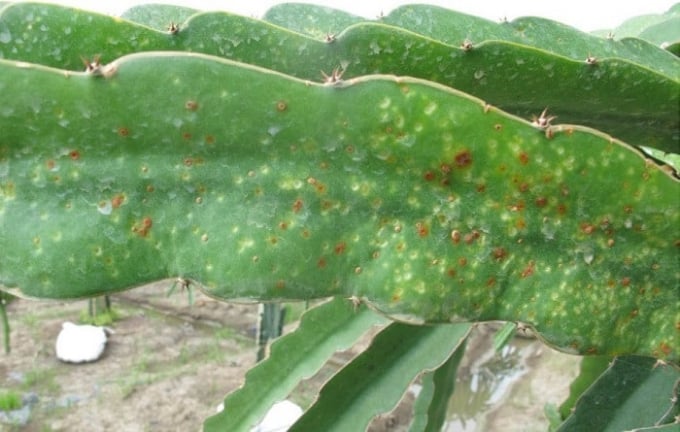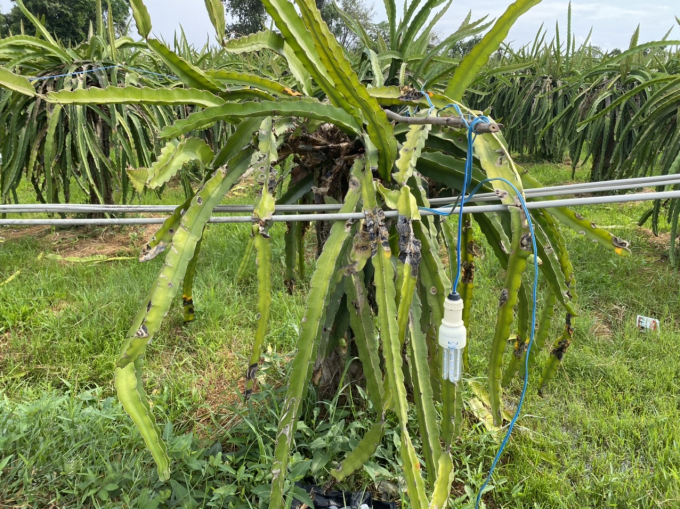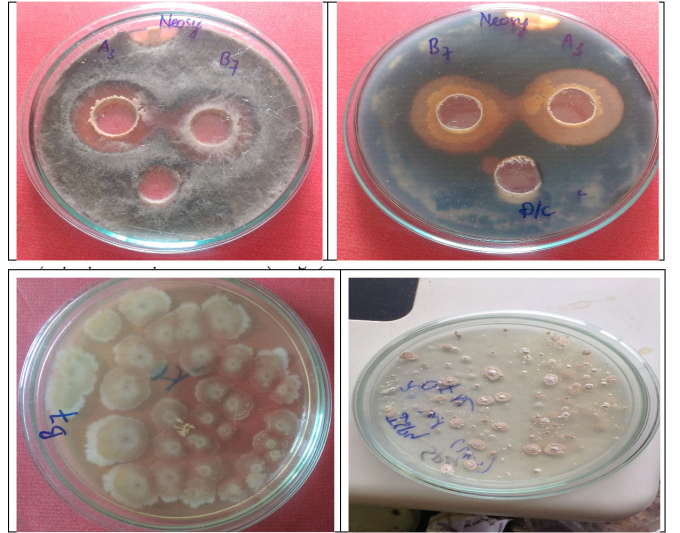May 29, 2025 | 05:49 GMT +7
May 29, 2025 | 05:49 GMT +7
Hotline: 0913.378.918
May 29, 2025 | 05:49 GMT +7
Hotline: 0913.378.918
Dragon fruit is one of the fruit trees with high export value, grown in provinces of Binh Thuan, Long An, and Tien Giang. However, in recent years, epidemics, especially BSD have reduced yield and product quality. This disease is caused by the fungus Neoscytalidium dimidiatum belonging to the Botryosphaeriaceae family, Botryosphaeriales order, and Ascomycetes class.

Symptoms of brown spot disease on dragon fruit leaves. Photo: TL.
Using chemical pesticides based on Azoxystrobin and Sifenoconazole can effectively control the disease. But chemical residue in the fruit will hinder exports to fastidious markets such as the EU, US, and Japan.
Coping with this problem, the IAE has studied the use of microorganisms as biological agents to control BSD on dragon fruit. This is an active research direction, meeting the quality and safety requirements for export and domestic consumption as well as contributing to limiting the use of chemicals in agricultural production.
To determine the microorganism density, the IAE focuses on agar plate researching methods to calculate the number of microorganisms per ml or per gram of sample through the number of growing colonies in the environmental plate.
Based on the determination of biological activity (ability to inhibit fungi) of microbial strains by diffusion ring measuring method on agar, the Environmental Biology Faculty under IAE used molecular biology technique to sequence 16s ribosomal RNA gene segments of researched microorganisms.

BSD on dragon fruit is a very difficult disease to prevent, so biological solutions are very important to control it. Photo: NNVN.
At the same time, the research team compared with the sequences available in the international gene bank EMBL by FASTA 33 method to identify the species of microorganisms.
After comparing with the European Community's list of safe microorganisms, the research team had identified and ensured the safety of the selected microorganism strain.
With soil samples taken from gardens with infected dragon fruit in Binh Thuan, Long An, and Tien Giang, the IAE scientists isolated and selected 10 strains of microorganisms that have inhibitory capacity against the fungus Neoscytalidium dimidiatum, of which 7 strains belong to bacteria group and 3 strains belong to actinomycete group.
The results of biological activity evaluation by diffusion method on agar plates showed that the control formulas (using sterilized distilled water) did not appear the fungus Neoscytalidium dimitiatum inhibition ring.
Specifically, strain A1 had a low inhibitory ability of Neoscytalidium dimitiatum (inhibitory ring diameter = 13.0mm). Trains A3 and B7 had the highest inhibitory ring diameter (21.0±3 and 23.0±3 mm respectively) and were selected by the research team to be used as materials.

Images of Neoscytalidium dimitiatum antagonistic rings (top image) and strain colony (bottom image) of B7, A3. Photo: VMTNN.
According to the Agricultural Biology Faculty, colony B7 raised on KB medium has round shape, serrated edge, and milky white color. Shaken culturing on a liquid medium after 48 hours, the highest cell density reached 7,109 CFU/ml.
The 16S rRNA gene sequence of strain B7 is 100% homologous (1414/1414 bp) with the 16S fragment of Bacillus polyfermenticus; 99.9% homology (1413/1414 bp) with 16S fragment of Bacillus axarquiensis, Brevibacterium halotolerans. Based on the results of gene sequencing and biochemical characteristics of the studied bacteria, strain B7 has similar characteristics to the strain of bacteria named Bacillus polyfermenticus.
Meanwhile, colony A3 grown on Gauze medium are round, 2.2-2.5mm in diameter, pinkish in color, and the colony feet stick deeply in the medium. Shaken culturing on liquid medium, after 72 hours forming small particles about 1mm in size, made on culture medium and on the wall of the flask formed a white scum ring, tightly adhered to the wall of the flask with the cell density reaching 2,109 CFU/ml.
The 16S ARNr sequence of strain A3 is 100% homologous (1500/1500 bp) with the 16S DNAr fragment of Streptomyces fradiae and Streptomyces rubrolavendulae; 99.8% (1497/1500 bp) with Streptomyces roseoflavus. Based on the results of gene sequencing and biochemical characteristics of the researched actinomycetes, strain A3 has similar characteristics to the actinomycete named Streptomyces fradiae.

The use of microbial strains to help resist BSD on dragon fruit trees needs to continue to be popularized and replicated. Photo: KS.
Regarding biosafety, according to European Community’s Directive 90/679/EWG, biological agents are classified into 4 safety levels, in which only microorganisms at levels 1 and 2 are used in production under normal conditions. Biosecurity levels 1 - 4 are general biosecurity levels, mainly for biological agents such as bacteria, viruses, fungi and parasites (both with and without genetic modification).
Thus, the research results show that Bacillus polyfermenticus and Streptomyces fradiae are classified as microorganisms with biosafety level 2, which can be widely used in the production of antagonistic fungus Neoscytalidium dimittiatum. Products applying methods of resistance to BSD on dragon fruit are eligible for exports to Europe.
The BSD was once considered an "incurable" for many large dragon fruit granaries. Since the beginning of the rainy season in 2012, the disease has spread widely, covering an area of nearly 1,000 ha, the rate of severe infection from 10% or more accounts for over 80% and causes damage from 20 to 50% of the crop.
After having instructions on the use of microbiological products, combined with sanitation of pathogens in the garden, cleaning the field, visiting the garden regularly, removing infected branches and fruits, collecting and burying them, sprinkling the field with lime, the BSD on dragon fruit has been no longer a concern.
The Southern Fruit Tree Institute (Vietnam Academy of Agricultural Sciences) advises people to actively fertilize NPK or other trace elements with a reasonable and adequate amount. It also advises farmers not to apply too much nitrogen at the shooting stage as this will make buds stout but susceptible to disease.
If the garden was seriously infected, farmers need to leave the buds in rainy weather. In addition, they should use more rotting organic fertilizers or micro-organisms to help the plant's root system be healthy to absorb more nutrients and be able to kill pathogens in the soil.
Translated by Linh Nguyen
/2025/05/25/4127-3-073637_820.jpg)
(VAN) Thanks to the promotion from an FAO-implemented project, vegetable production in greenhouses in Moc Chau has seen strong development, from 1.5 hectares in 2021 to nearly 50 hectares in 2024.

(VAN) FAO has recently supported USD 140,000 to implement the project 'Risk mitigation human-animal interface risks through disease control initiatives in pig farming.'

(VAN) The People's Committee of Tra Vinh province has approved an adjustment to the investment policy for the Green Hydrogen Plant project, increasing its area to approximately 52.76 hectares.
![Reducing emissions from rice fields: [2] Farmers’ commitment to the soil](https://t.ex-cdn.com/nongnghiepmoitruong.vn/608w/files/news/2025/05/05/dsc08881jpg-nongnghiep-140632.jpg)
(VAN) Clean rice cultivation model in Thuong Tan commune, Bac Tan Uyen district, is assisting local residents in achieving sustainable agriculture by substantially reducing costs, increasing productivity, and protecting the environment.

(VAN) At the conference to disseminate Resolution No. 68, AgriS introduced its digital agricultural ecosystem and reaffirmed its commitment to accompanying the Government in promoting private sector development and sustainable agriculture.

(VAN) 'Blue Ocean - Blue Foods' initiative is designed to restore marine ecosystems and establish sustainable livelihoods for local communities by cultivating a minimum of 1,000 hectares of cottonii seaweed in the first three years.
/2025/05/21/4642-3-112707_603.jpg)
(VAN) The V-SCOPE project has made direct contributions to three out of six pillars of the Comprehensive Strategic Partnership between Vietnam and Australia.